Nairs of Kerala and their history, culture and tradition
Nairs — Nair of Kerala, their Origin, History, and culture, Also referred to as Nayer
🌺🌺Simple answer — A Devadasi shudra caste/community from Kerala 🌺🌺
Here I’m presenting 6 pages of facts from impartial researches (you can see them on google books and online university libraries) conducted by foreigners and other intellectuals in and outside Kerala. So, please read each section and see the associated proofs as well. Other answers here in this forum are from Nair community members, who are well known for their aggressive boasting and show off attitude.
🌺🌺 Now, Let’s put boasting aside and start listing various Nairs — 🌺🌺
Among 18 Nairs, Akattu charna nayars (clerks, domestics and scribes) , Urali/Oorali nayars (masons & they also did TODDY TAPPING!) , Pallichan (palanquin bearer), Chembu-kotti (copper-smith), Chakkala nayar, Vattakadu nayar (oil mongerer), Vilakkithala nayar (barber), Veluthedathu nair (Washer-man), Attikurisssi nayar (funeral priests) are all nayar castes only different in their ritualistic ranking from the ruling elite or mercenary/soldier ranks. Do not overlook these professional divisions and ego-based claim that all nayars are ruling elite. It is anthropologically and historically incorrect. Kindly read documents and research articles more objectively before making bogus boasting claims!
Lexicographers like P. Narayana Panicker and Sanskrit authorities like Kanippayoor says the concealed meaning of nair — nai : the totem dog “suna-eva-vritty” dog-like-loyalty exhibiting serviles but not derogatory when used in a totemic sense like in purusha-pungava or bull-man and not the much publicized glorifying etymology involving the Sanskrit word Nayaka or leader!
As modern online Nairs claim, the translation of Nair into Nayaka doesn’t make any sense at all, in fact logically absurd and funny…..! DO YOU KNOW WHY ? Because, how can Vilakithala (barber), Veluthedathu (washerman), Oorali (mason & toddy tapping), Chembukotti(Copper smith) and other many nair group (out of 18 divisions) who were doing menial jobs can be considered as Nayakas? 🌼🌼
- 🌺 Though Nairs are a Devasadi / Shudra community from Kerala, the modern day online nairs even started claiming as kshathriyas, but the original royal kshathriyas of Kerala (who got their lineage from Chola, Chera and Pandya Dynasties) or other historians from Kerala and abroad, won’t accept such claims by nair community members. Another example of nair characteristics, just mere boasting! In fact, Nair community was clearly categorized as Shudras in all the Brahmincal records / writings and old Travancore royal records. In early 1900s, NSS — a nair organization submitted a petition to the royals to remove shudra references from all the royal/govt records in Travancore, which was later accepted and approved.
- 🌺 Kanippayyur Namboothiri, a respected historian from Kerala refered nayars as — 🌸“Patthappante Makkal” 🌸
- 🌺 As Kanippayoor mentioned meaning of Nair is Nai — “suna-eva-vritty” dog-like-loyalty exhibiting serviles — might be the genuine origin. It will be funny to even think that a Vilakithala, Veluthedathu, Oorali nairs are Nayakas!
- 🌺 Buchanan Forster’s India, in which he says “NO NAIR KNOWS HIS FATHER”),
- 🌺 Latham states in his book, “ No Nair son knows his own father and, vice versa, no Nair father knows his own son
- 🌺 As per records, nair women used to give birth to minimum 10 children from 10 different husbands. This proves their Devadasi — Sambandham practices/tranditions with Brahmins and Kshatriyas. As per Royal records, Travancore royals did only allow brahmins to cook food for them, shudra nairs were not allowed to enter the Travancore palace kitchen
Please see the picture below — A painting of a Nair man walking out of his house to sleep at courtyard, When a brahmin came to his house to have sex with his wife (This practice existed in all Nair divisions — kiriyath, illath and charna nairs which are genuine shudras of kerala)
Nairs of Kerala originated from the Adivasis, says MGS Narayanan
https://www.deccanchronicle.com/nation/in-other-news/081116/nairs-of-kerala-originated-from-the-adivasis-says-mgs-narayanan.html
Note: M.G.S. Narayanan is a Nair
KOTTAYAM: Historian M.G.S. Narayanan says the Nair community may have originated from the Adivasis, the state's native tribes of yore. Mr Narayanan raises this argument in his new book, Kerala Charithrathinu Chila Thiruthukal based on his 1972 thesis published in 2013 - The Perumals of Kerala, a pioneering study tracing the origin of the community. According to Mr Narayanan, a former chairman of Indian Council of Historical Research, the Brahmin settlers who received agricultural lands as grants from local chieftains used to include the native tribes as tenants for carrying forward the agriculture.
These people must have been called Nairs (Nayakars or leaders in Sanskrit) and in the course of time these tenants who cultivated this land on a hereditary basis where organised as a sub-caste called Nairs. “The Nairs of the state doesn’t have unity. The name Nair may have gotten from the Sanskrit word of Nayakan. The Nayakan in the army has turned as Nair and a sub-caste later," Mr Narayanan says in his book. “Those including Veluthedathu Nair, Chakkala Nair and Vaniyar are all commonly known as Nairs in our period. The Nairs here are those belonging to the Adivasi tribes of Paniya and Kurichya. Then they became the Nayakans of the army of the Brahmins and later Nairs.”

Note: . Some modern day nairs claims that, Sambandham practice was only among poor nairs. But the historical references show that, only 10% of the nairs were wealthy (Wealthy mean, out of that 10% nairs not all were super wealthy, because most of those so called wealthy nairs were intermediary land tenants of Brahmins Janmis. Super rich Nair Janmis were very few in number. Thats’s why land reforms act affected Brahmins than Nairs), rest 90% were relatively poor. Also, it is very obvious that a rich namboothiri or a royal kshathriya won’t go to a poor nair lady’s house for Sambandam sexual practice. They would only go to a Nayar lady of their stature. On top of that, there is a novel in Malayalam called Indulekha, which was written by O Chandhu Menon, who was portraying the difficulties, challenges and evils associated with illicit Sambandham sex practice. In his novel, the central character — Indulekha (a nayar — menon woman) was acquiring English education to fight against the sexual exploitations of Sambandham practice. From that context, it is clear that, poor nair ladies can’t for English education and only rich nair lady can attain English education. if so it is obvious that sambandham practices was there among nairs regardless of the wealth and financial status.
🌸🌸🌸🌸🌸🌸🌸🌸🌸🌸🌸🌸🌸🌸🌸🌸🌸🌸🌸🌸🌸🌸🌸🌸🌸🌸
🌺 🌺 Whether rich nair women were involved in Sambamdham?! 🌺 🌺
- Vengayil Kunhiraman Nayanar is considered as one of the top richest Nair Janmi in Kerala. He was born to Vengayil Kunhakkam Amma and Puliyappadappu Haridasan Somayajipad, a Nambudiri Brahmin from Perinchellor Graamam, Taliparamba. You see it is very obvious that even a richest nair was born out of Sambandham!
- Mannathu Padmanabhan and Chattambi Swami and most other well known old age prominent nairs were born out of Sambandham.
🌸🌸🌸🌸🌸🌸🌸🌸🌸🌸🌸🌸🌸🌸🌸🌸🌸🌸🌸🌸🌸🌸🌸🌸🌸🌸
🌺 🌺 🌺 🌺 🌺 🌺 🌺 — SAMBANDHAM — 🌺 🌺 🌺 🌺 🌺 🌺 🌺 🌺 🌺
Sambandham is tradition of temporary marriage or sexual relationship with a Nair girl or married Nair woman. Other than elder son, all other sons of Namboothiri brahmin will visit any Nair married woman of his choice who is living with her parents and brother. Some few cases Samantha Kshathriyas of Kerala men were also involved. That’s the prime motivation for a modern day nair to claim Kshathriya status. Now, Sambandham man will present Nair lady/girl a wedding shawl called pudava(white saree with golden border) and she will give him Thamboola(betel leaf and areca nut). Then they will go to bedroom and that Namboothiri brahmin will have sex with her at night and next morning he will go back. “After having sex with a Nair lady, every Brahmin guy has to go through a purification bath ceremony prior to re-enter his native house. Because, as per brahmins, touching a Nair’s body will make him impure”.
Nair woman who actually is married with a Nair husband can have Sambandham with any number of Namboothiri brahmin. And when she is pregnant and delivered child ,that child will be Nair and not Namboothiri brahmin.She will be honoured if she has Sambandham with as many as may be a dozen men.Nair woman with Sambandham will get money,food and honour by Namboothiri brahmin.
In modern days, majority people want male child, but in old days Nairs prayed for girl child, that will help them to attain wealth. Because, most nair youth were useless (thats how they attained the name — andi nair), or spear (kuntham) holders guards.
In this case children will be with mother and her parents.Her married husband will be living with his parents and taking care of his sisters children.This system is called MATRILINEAL where woman is incharge of a house and she will get property of parents .
Please see the below proof:
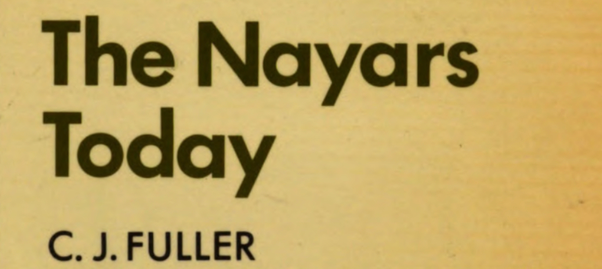
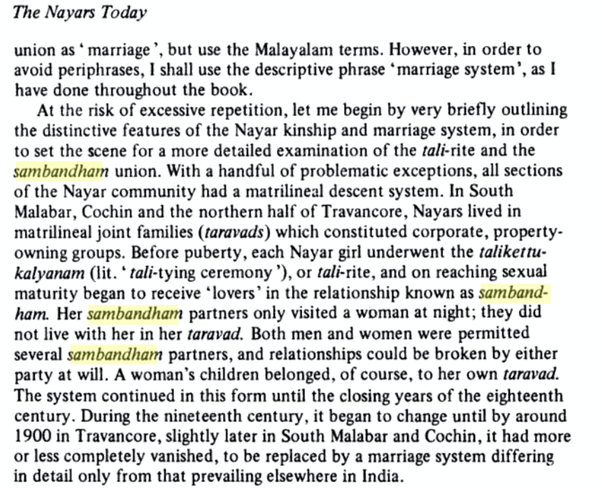
🌺 🌺 🌺 — NAIR WOMEN RUINED THE LIFE OF ANTHARJANAMS — 🌺 🌺 🌺
Namboothiri brahmin women are called Antharjanam, which means the one who lives indoors.They lived a strange secluded life.The antharjanam allowed only praying and cooking in the kitchen.If she has to go out to some temple or relatives ,she has to cover even her face with palm leaf umbrella and be accompanied by a maid.This was just to keep their woman virgin.They could not wear gold jewellary instead could wear silver or brass jewellery.
Because of the reason that only elder son can marry Namboothiri woman and all other son will be in sambandham with Nair women, many Namboothiri girls were unmarried or had to marry old Namboothiri husband whose wives are dead. Also due to marriage with old Namboothiri there were many young widows who could not remarry. Their lives were sad and if by chance they had sex with any Nair or low caste man she has to undergo procedure of Smarthvicharam.
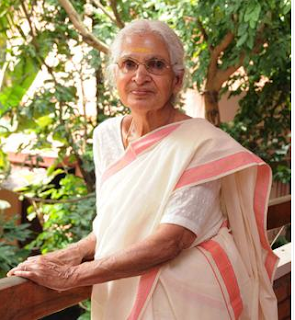
Devaki Nilayamgode
Antarjanam Devaki Nilayamgode wrote book named ‘Antharjanam’ in malyaly (which is translated in english) when she was aged 75.She begins the book like this
“I am 75 year old antharjanam from Nilayamgode Illam…..Achan(Father) was 68 when i was born….I do not remember Achan…..
🌺🌺 🌺 Tipu Sultan’s proclamation against Nairs 🌺🌺🌺

ഒരേ സമയം സംബന്ധം എന്ന ചടങ്ങിലൂടെ നായർ സമുദായത്തിൽ വേശ്യാ വൃത്തിയെ പ്രോത്സാഹിപ്പിക്കുമ്പോൾ തന്നെ സ്വ സമുദായത്തിലെ…boolokam.com
🌺🌺 🌺 Indulekha 🌺🌺🌺
Please watch the below link, a cinematic version of Indulekha by O Chandhu Menon, which depicts Sambandham practice with Nair women and how Kerala Brahmins / Namboothiri’s imposed it as a right on Nair women.
Please see wikipedia — Nair — Wikipedia (The Nambudiri Brahmins were at the top of the ritual caste hierarchy and in that system outranked even the kings.They regarded all Nairs as shudra)
Since Nairs allowed devadasi sexual exploitation of their women, with brahmins and kshathriyas, they used to enjoy special privileges in old days and even accumulated lot of wealth and fair skin offsprings through Sambandham practice.
But, today they don’t have any upper hand in Kerala, as compared to Muslims, Christians and ezhavas in Kerala
Some nairs claim as Nagavamshi tribe and some others even say from Nagavamshi royal dynasty, though this was proved to be false, since no records of the existence of a nagavamshi dynasty in any historical reference. So Nairs are thought to be an old tribal community, who used to worships nagas/snake God. In old days tribes used to worship snakes and natural calamities that pose threat to their life, especially when they live in a dense forest with lot of challenges around them.
🌺Modern day Nair’s greed to become kshathriyas and the facts as follows🌺
Nairs are shudras, not kshatriyas and no one consider them to be(Other than new gen online nairs trying so hard to portrait them as kshatriya because they are too ashamed of their concubine shudra history )
Nairs were triabls in kerala and many higher castes used them as concubine (By Brahmins, Temple servant caste, and by royals also)
The Royals of kerala(Samantha kshatriyas) usually have titles such as VARMA, RAJA, THAMPURAN etc They isolate them from ordinary Nairs (Such as kiriyath, sudran and charnas) Even nowadays they don’t usually make marriage alliance with nairs
Kerala Nairs consist of mainly 3 subcastes (kiriyam, illath, and charna) and these subcaste are nothing but sudras only
Throughout the history Nambiar, Menon, pillai or whatever nair it is(These were the titles granted by namboodiris and local rulers to nairs in return of numerous services provided ) they were classified as Sudras and considered themselves as sudras only
Other minority nair subcastes are mostly immigrant castes and absorbed in to nair caste fold when they came to Kerala (Many of them had vyshya status in the states they came from but may or may not treated as same in kerala e. g: tharakan and mannadiyar)
Please see the picture above — Painting of Nair man walking out of his house to sleep at courtyard , When a brahmin came to his house to have sex with his wife (This practice existed in kiriyath, illath and charna nairs which are genuine shudras of kerala)
Women from these subcastes used to be concubines / courtesan of royals also, so i don’t know whether it’s the reason behind such claims
This also shed light to the reason why these sudra nair subcastes was placed above other lower and immigrant nair subcastes which didn’t much involved in such practices, considering the fact brahmins and roryals ;The beneficiaries of such practices decided caste hierarchy below them)
I would like to conclude this answer by quoting famous novelist Thakazhi sivasankara pillai(Who is a nair himself) regarding this topic
“The nobility of a Nair house increases as there are more marks of torch lighted off on the courtyard“
❤️❤️❤️❤️❤️❤️❤️❤️❤️❤️❤️❤️❤️❤️❤️❤️❤️❤️❤️❤️❤️❤️❤️❤️❤️❤️
🌺HOW & WHY MATRILINEAL SYSTEM STARTED IN NAIR COMMUNITY 🌺🌸
❤️❤️❤️❤️❤️❤️❤️❤️❤️❤️❤️❤️❤️❤️❤️❤️❤️❤️❤️❤️❤️❤️❤️❤️❤️❤️
Short answer — As Latham states in his book, “ No Nair son knows his own father and, vice versa, no Nair father knows his own son. What becomes of the property of the husband ? It descends to the children of his sister.”
Picart quotes Oviedo as stating that the Nair women regard association with men to be an institution so holy that they believe virgins to be secluded from paradise, but this seems merely an excuse put forward by someone of the race, who has been ashamed of this social custom.
🌼🌼Nair Matrilineal, how it worked:🌼🌼
A man’s mother manages his family, and after her death his eldest sister assumes the direction. Brothers almost always live under the same roof, — but, if one of the familv separate from the rest, he is always accompanied by his favorite sister. Even cousins, to the most remote degree of kindred, in the female line, generally live together in great harmony : for in this part of the country, love, jealousy, or dis-trust, never can disturb the peace of a Nair family. A man’s movable property, after his death, is divided equally among the sons and daughters of all his sisters. His land estate is managed by the eldest male of the family, but each individual has a right to a share of the income. In ease of the eldest male being unable, from infirmity or incapacity, to manage the affairs of the family, the next in rank does it in the name of his senior. Under these social rules it is not easy to see the inducement to the Nair to marry, as he has all the burthen without any of the enjoyments of wedded life.
🌸🌺🌸See the below note from the book: How and why Nairs ladies went for Sambandham with Namboothiris and their Nair men (sons) were left to become spear holders for Rajas, drunkards and sadly most of them lead an unmarried life 🌸🌺🌸
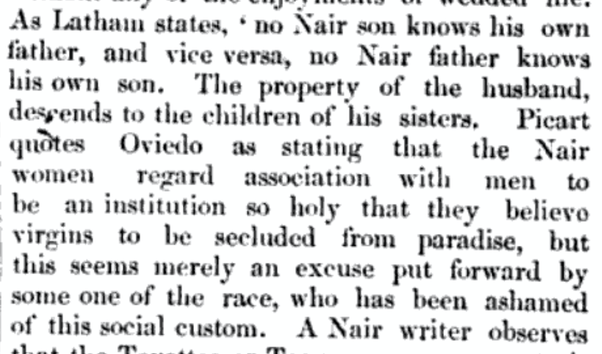

❤️❤️❤️❤️❤️❤️❤️❤️❤️❤️❤️❤️❤️❤️❤️❤️❤️❤️❤️❤️❤️❤️❤️❤️❤️❤️
🌺🌺“NO NAIR KNOWS HIS FATHER — Traveller — Buchanan Forster ”🌺🌺
Buchanan Forster , a traveler — in his book states that due to sambandam “No nair knows his father”
Forster, Buchanan’s India — By William Fordyce Mavor
Nair women are proud of reckoning among their favored lovers many brahmin, Rajas or other person of high birth. It would not appear, however, that his want of restoration has been injurious to the population. When a lover receives admission into a house, he commonly gives his mistress some ornaments and her mother a piece of cloth. But these presents are never of such value, as to give room for supposing that the women bestow their favors from mercenary motives (primarily concerned with making money). To this extraordinary manner of conducting the intercourses between sexes in Malayalam, may perhaps be attributed the total want, among its inhabitants of that penurious disposition so common among them. All the young people view with each other what shall look best, and who shall secure the greater share of favor from the other sex, and an extraordinary thoughtlessness concerning the future means of substance is very prevalent. In consequence of this strange manner of propagating the species, no Nair knows his father and even man looks upon his sister’s children as his heirs. He indeed looks upon them with the same fondness that fathers
Note:
A perfect example is Mannam and chattambi swami, they both born out of sambandam and got angry and upset about that concept since they never got love and care from their sambandham father.. So they acted against it. Because a Nair kid born out of sambandan was considered as a nair, who was supposed to keep 24 feet away from a brahmin (in old days). Whereas his mothers body was free to exploit by a brahmin at any time as per his wish.
🌹🌹 ABOUT NAIR ladies — by a 17th century, the Dutch traveller 🌹🌹
“Matriliny and its Discontents” , by G Arunima — see the below references- (absence of “chastity and shame” in Nair women;) In the 17th century, Linschoten, the Dutch traveller to Malabar described the Nairs as the “most leacherous and unchast nation in all the Orient”1, where women had a series of lovers, often in one night, without it causing any jealousy or difficulties. Linschoten was not alone in holding this view; most medieval Europeans travelling to the Malabar coast left behind tales of verdant lushness and female excesses. Of course, both men and women were promiscuous, but what shocked the European mind was the absence of “chastity and shame” in Nair women; so much so that many like Duarte Bar- bosa stated that Nair women “do no business, eat the bread of idleness, and only get their food to eat by means of their bodies because they do not refuse any bra man or nayr who pays them…”2, making an implicit association between female sexuality and prostitution. This shocking state of affairs was made possible by the absence of a “marriage law”, not only for the “great Nair lineages” but also for the kings of the region. By the last quarter of the 19th century young Nair men in Malabar were clamouring for precisely such a law — one that would enable them to legitimise their matrilineal sambandham or customary marriage, unions as monogamous marriages,with the attendant advantages of conjugal co-residence and shared property rights in the nuclear family.Dissensions over property and anguish over morality had held the Nairs in a vice like grip for a long period of time. At the heart of this crisis were the critical cultural and ideological trans- formations in the matrilineal system that was prevalent.
🌺🌺 Some online Nairs even boast that Marthanda Varma is a Nair! 🌺🌺
Marthanda Varma was born in 1706 to queen Karthika Thirunal, the Queen of Attingal, and Raghava Varma of Kilimanur Palace.[1] Queen Karthika Thirunal — an adoptee from the northern Kolathunadu ruling family — was the senior queen of Attingal at the time.
Imp Note: — Both his father and mother are Kshathriyas who are having lineage to Chola, Chera and Pandya. Some modern day nairs claim that his mother is from Kolathunadu rolling family and they were nairs, this is utter nonsense and a false claim without any scientific / DNA backing. Because there were many nair families in Travancore, Kochi, Kozhikodu Kingdoms, but the queen was adopted from far Kolathunadu (old Kannur) to keep the royal lineage in tact. Otherwise if they want a nair lady, they could have easily adopted from Travancore or Kochi, the near by places, so they don’t have to go further north of Kerala to Kannur.
About Kolattunādu (Kola Swarupam, as Kingdom of Cannanore in foreign accounts, Chirakkal (Chericul): The ruling house of Kolathunādu, also known as the Kolathiris, were descendants of the Mushaka Royal Family, and rose to become one of the major political powers in the Kerala region.
🌺❤️WHAT WAS SAMBANDHAM AND IT’S IMPLICATIONS ON NAIRS❤️🌺
Most online modern Nairs are desperately trying to glorify evil Sambandhan practice, BUT….. Before they do so, they must read Mannathu Padmanabhan’s autobiography. Then they will understand the truth, shame and evils associated with sambandham practice. In fact, most online Nairs are knowingly or unknowingly forgetting the famous statement and proclamation of Mannathu Padmanabham in which he asked Nair youngsters to wake up and fight against the Sambandham practice. His famous proclamation statement as follows
“Throw away Kindi and water….. The womanhood of my nair community will not be left to the lust and sexual pleasures of the Brahmins”
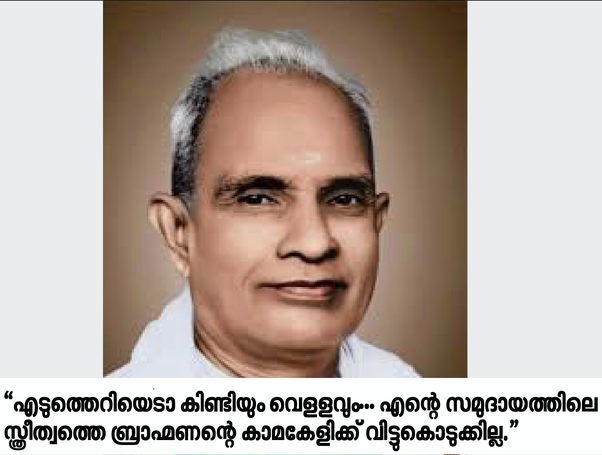
(Note: Kindi means a vessel that used in olden day to store water to wash the face and feet of a guest and it also considered as a welcoming symbol for brahmins to enter Nair houses for sambandham sexual practice at “night time”. Here, please note one key point, Brahmins used to enter a Nair house only at “night times”. And other important evil part here, “After having sex with a Nair lady, every Brahmin guy has to go through a purification bath ceremony prior to re-enter his native house. Because, as per brahmins, touching a Nair’s body will make him impure”. O Chandumenon wrote and acted against the evil barbarian behavior of brahmins.
In fact, two nair icons, Mannathu Padmanabhan (founder of Nair Service Society — NSS) and Chattambi Swami were born out of sambandham practice. So. their entire life was dedicated to fight and stop sambandham practice among nairs because they personally had a very bad experience, discrimination as untouchables and negligence from their own Namboothiri sambandham fathers. As per nair sambandam custom, brahmins (Kerala Namboothiris and in some cases few Royal Kshathriyas) target nairs women and come to nair’s house with self-proclaimed authority and hand over a pudava as the mark and initiation of sambandham and thus they authoritatively seal and enslave Nair women as their Sambandam partner (keep in mind, nair women were not considered as wife in sambandham until a law passed in 1930s). So, after this nominal sambandham pudava ceremony, they enjoy sex with those nair ladies, until those Namboothiris find another Nair lady as their sambandham prey (or get tired of their current sambandham partner, and keep in mind, thus Nair ladies used to have a minimum of 10 Sambandham partners).
Though it was a clear exploitation, Nairs ladies considered it as a great privilege and pride to share their body with an upper caste brahmin (a pride and privilege that originated from their caste inferiority complex towards Namboothiris and Kshathriyas). Having said that, this close physical proximity was only towards Nair ladies, but nair men and even the child who born out of Sambandham were considered as untouchables nairs and it was mandatory for Nair men, and even the poor nair child who born out of sambandham must keep 24 feets away from a Brahmin Namboothiri, even if the Brahmin man is their father!. The worst part of Sambandan was, these Namboothiris considered themselves as pride sexual pleasure givers and sperm donors for Nairs, but they didn’t share their wealth nor they provided any financial support for those kids born out of a nair lady. Brahmins even boasted about their elite sperm donation and considered it as a great help for Nair community, which they believed to have provided good looking and intelligent nair kids than other communities in Kerala. This was clearly mentioned in Kanippayyur Namboothiri’s Nayar History writings.
🌺🌺🌺🌺🌺🌺🌸 — NAIR WARRIORS — 🌸🌺🌺🌺🌺🌺🌺
🌼Though the online nairs, claims or boast themselves as warriors and heroes (if you ask them to list 10 heroes and or warriors of old age, they would either change the subject or shamelessly run away). As per the assumption, the so-called Nair brave warriors miserably failed or say were literally weak to stop the above mentioned illicit sambandham practice on their women. So naturally, a question arises here, what kind of brave warriors were they? Why they didn’t have the courage and strength to stop the sexual exploitations happening in front of theirs eyes and inside their homes. This in fact, proves that modern-day nairs are simply boasting or making the claim that the majority of old-days Nair men were warriors. So it assumes that most nair men were just employed as spear (kuntham) holders and palace guards and, in reality they were cowards. If they couldn’t protect chastity (charithryam) of their women, how can they be even considered as courageous warriors??!! A typical nonsense boasting from a Nair person!
🍀🌸🌺🌸 BUT DRASTIC CHANGES STARTED IN the 1900s And NAIR men under NSS organization attained courage to talk against Brahmins/Namboothiris 🌸🌺🌸🍀
By the beginning of 1900, led by Mannathu Padmanabhan, young men of Nair community started revolting against Sambandham. This resulted in the passing of the following laws:
Thus the legal validity for Sambandham marriage came to an end with the enactment of the Nair Regulation Act of M.E.1100 (1924 A.D.). Up to this, there was no validity for theirSambandhams. The new regulation prohibited them to own and disown wives at their pleasure. Certain conditions were also laid out for divorce.
There was also a Madras Namboothiri Act of 1933: The declaration and these Acts led to a sudden decline in the number of Sambandam marriages.
But when the law passed against sambandham, that made it mandatory for a brahmin who involves in sambandham must share his wealth to the children born out of Sambhandam, the sexually aggressive brahmins of those days immediately retreated from the sambandam practice!!!!. “Until that time, it was completely dependent on the intelligence and tactics of a nair women, on how to grab wealth from a brahmin (who mostly owned lands in Kerala and gathered tremendous wealth from temple and rulings kings). However, brahmin were not legally obliged to give wealth and money to those women or the kids born out of sambandham. Brahmins exploited the inferiority complex of the nair community. But, when the law enforced in 1903s, brahmins gradually retreated from the sambandham practics. This retreat from Sambandam practice proves that, brahmins were fine to give wealth as per their wish, but they were not ready to legally share their wealth with their nair kids. Finally, after 1930’s sambandam practice vanished away from Kerala society and Nairs started having Nair father and mother!!. Even after reading all these facts and records, if a modern-day nair claims it as a normal legal practice/marriage, then he is entitled to prove why the brahmins stopped sambandham after the above mentioned law was passed.
Now here is some more additional facts from the old records. In old days not only brahmins had sambandam with nairs, but even few kshatriyas were also involved in sambandam with nairs. The main reason for such a sambandam practice, the Samantha Royal kshathriyas were very few in numbers (descendent of Chola, Chera & Pandya dynasties) . Though nairs were shoodras, to having male offsprings or say kids within a minor kshathriya community wasn’t that easy. You can see a lot of such adoption practices with Travancore royal family. And the other key point here, kshathriyas could not marry with brahmin ladies. That was a solid NO at that time. So the only option left for royal kshathriyas of those days, was to go for sambandham with nair women, who were in tremendous ecstasy and joy to give birth for royals. And Nairs shoodras were next in line and also in the hierarchy order created by brahmins. This is why some modern day online nairs claims kshathriya status, basically their women shared bed with original Samantha Kshathriyas of Kerala.
🌺🌺More proofs about sambandham obtained from various books and research papers by foreigners and other reputed Kerala researchers🌺🌺
- 1.

- 2
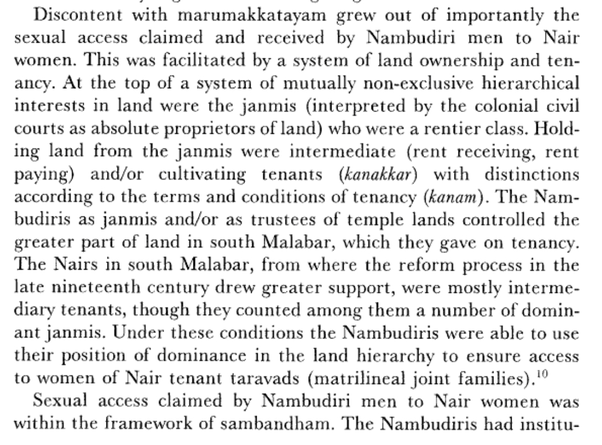
- 3

- 4
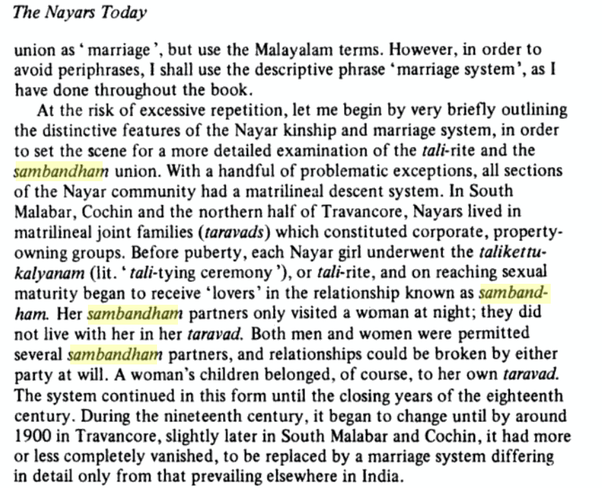
- 5
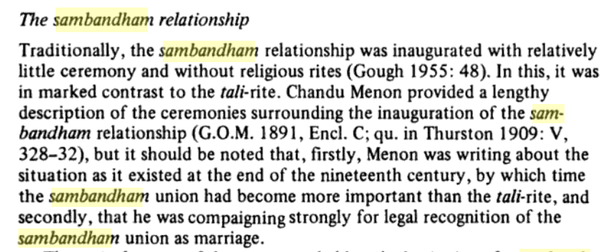
- 6
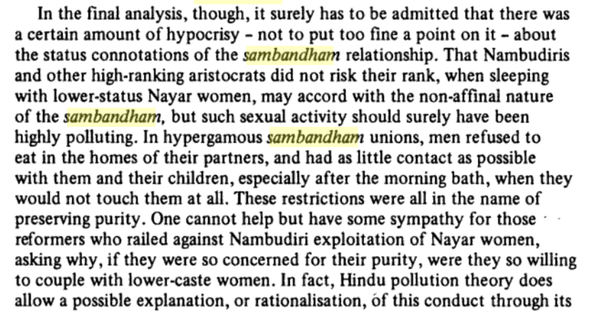
- 7

- 8
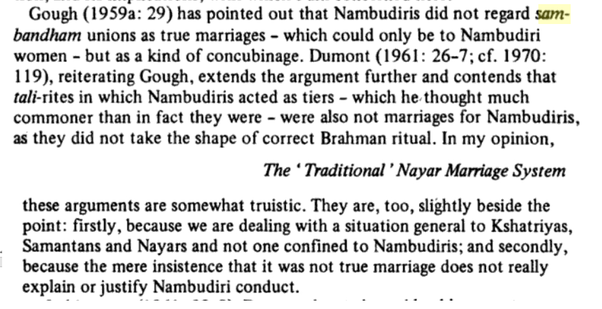
- 9
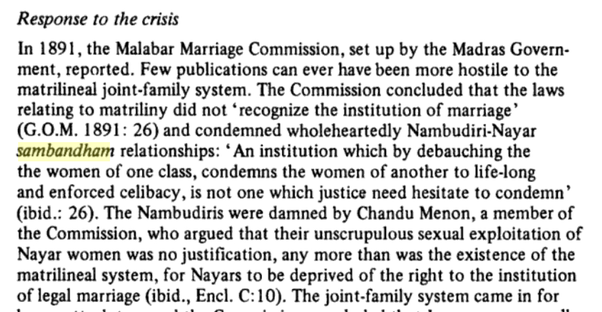
- 10

💪💪💪💪💪💪💪💪💪💪💪💪💪💪💪💪💪💪💪💪💪💪💪💪💪💪
🌺🌸 — NAIRS vs EZHAVAS / THIYYAS as warriors and Kalari experts — 🌺🌸
💪💪💪💪💪💪💪💪💪💪💪💪💪💪💪💪💪💪💪💪💪💪💪💪💪💪
As per various historical references, both Nair and Ezhava men were active in royal armed forces as soldiers and royal guards. Veluthampi Dhalava, The Paliath Achan — a Nair chieftain, Ettu veettil pillammar (mostly rich landlords) and some other commanders were from Nair community. But the irony here, they were very few in number that you could count with just one hand! Basically, hardly few of them were known for their bravery and Kalari expertise! However, there were brave warriors and Kalari experts from other communities in Kerala as well. For example, Ezhavas had the monopoly of Kalari and Ayurveda practices. The Ampanattu panicker (Chief commander of chembakassery Raja), Cherayai Panickers & Ampalattil Panickers were renowned Kalari experts, Aramkunnam Kalari experts of Eranadu kingdom, Umayanadu Kizhavan (Chief of Kollam Raja), Moolor Thandan, Kochu Krishnan Asan — a Kalari trainer of Marthananda Varma (helped him to combat ettuveettil pillammar), Varanappallil Panickers (Royal Commander of various Rajas) Akkathayyadi paniker (Commander of Kottarakkara — Elayidathu Swarupam), the famous Kadathanadan warriors like Aromal Chekavar, Kuroolli Chekon, Unniyarcha, Kalari trainers for Ettuveetil pillammar — Kulathoor ezhava Kalari panicker of Travancore (They even have a Kalari Devatha temple at Thozhuvancodu), Arattupuzha Velayudha Panicker (son of Kallisseri Perumal Chekavar) & almost all the royal palace Kalari trainers were ezhavas, thats how Lord Ayyappan went to Cheerappan Chira ezhava tharavadu for Kalari training. So, it is obvious that both Nairs and ezhavas were into armed forces, martial arts and trainings. Ref: Chekavar — Wikipedia
Imp Note: Thacholi othenan Kurup is considered as Nair. He was titled with kurup, but not nambiar, this was bit strange. Those days Kurup was a title given to anyone who was proficient in kalari or jolsyam. And Othenan mother was a thiyya lady called akkama uppati. So Othenan’s lineage need further confirmation.
In fact as per historical references, It was ezhavas who trained nairs kalari and related Marama chikitsa and its form varma adi. If you take some examples for famous king Zamorin, kallingu madathil an ezhava family of calicut were the kalari trainers, Cheerapanchira and Vallabhasseril were the kalari trainers for Pandalam Royals and If you take kayamkulam kingdom, alummootil channars were kalari trainers and Varanapallil panickers were their commanders. Also, Mudakathur (Mavelikkara), Lakshana panickers were famous kalari trainers. Mundakkal chekavars were the part army of venadu and they were also kalari trainers. Puthiooram veedu was well known for kalari and related Martial arts. Tulunadan kalari was also run by ezhava trainers.
🌸🌸🌸🌸🌸🌸🌸🌸🍀🍀🍀🍀🍀🍀🍀 🌸🌸🌸🌸🌸🌸🌸🌸
Imp point: NOT EVEN A SINGLE NAIR LADY (in the past or present) WAS KNOWN FOR HER BRAVERY, WHEREAS UNNIYARCHA AND NANGELI WERE PROUD SYMBOLS OF EZHAVA — THIYYA BRAVERY, along with the modern day Iron Lady — K. R. Gowri Amma and others (including even the present health minister)! This again proves that Brahmin Namboothiris were not only silenced nair men, but also enslaved nair women to their will! Until the great Mannathu Padmanabhan emerged as a hardcore Nair icon to fight against the evils
Pict: Unniyarcha — Wikipedia (The jewel of the Indian womanhood, the crown of feminine courage and fortitude, the female martial genius and the Jhansi Rani of Kerala who proved her invincibility, hastens to adore the “beauty” of swordsman)
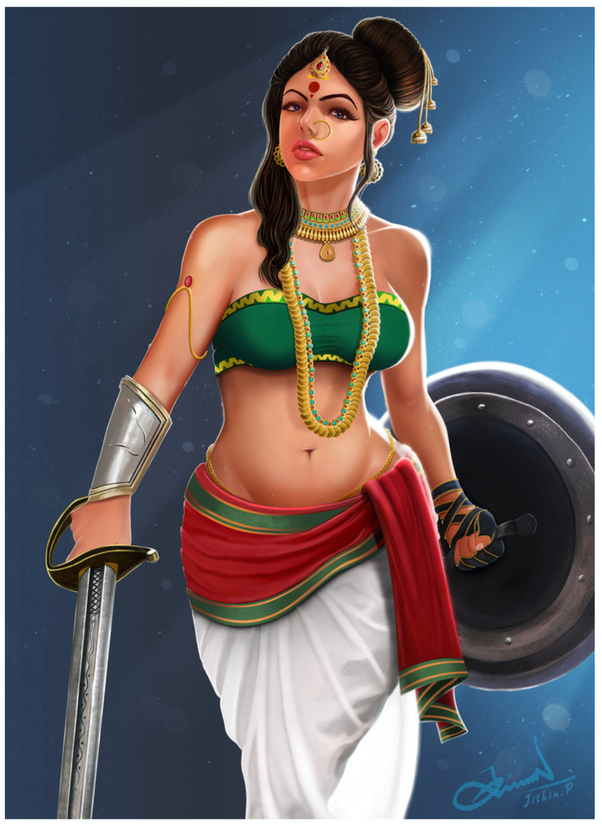
🌸🌸🌸🌸🌸🌸🌸🌸🍀🍀🍀🍀🍀🍀🍀 🌸🌸🌸🌸🌸🌸🌸🌸
🌺🌺 Veluthampi Dhalava’s infamous Nair love and ezhava hatred! 🌺🌺
As per ancient and royal records, Veluthampi Dalava ousted ezhavas warriors from Travancore army, converted it into a Nair brigade. Dhalava’s action instigated Nair — Ezhava feud, which later resulted in a many clashes and atrocities in old Travancore region. British exploited the opportunity and recruited ezhavas into their army and finally used them to kill Dhalava. Although, Dhalava was very communal and against ezhavas, finally an ezhava business man (Gokulam Gopalan) made a film to glorify Dhalava.
So, it is very obvious that both Nair and Ezhava men were chieftains and army men of old royal army units, but who among them were more aggressive and truly courageous ? A question that need to be answered! Having said that, even today the aggressiveness of ezhavas youth are quite explicitly visible and being exploited by political parties and thus they are still the part of aggressive political encounters and physical clashes that sometimes results in brutal murders.
💪💪💪💪💪💪💪💪💪💪💪💪💪💪💪💪💪💪💪💪💪💪💪💪💪💪
🌺🌺🌸 BRAHMIN JANMIS SYSTEM — VEDIC VARNA SYSTEM 🌸🌺🌺
- Helped Brahmins to enslave Nair Women as their Sambandham partners, along with that lack of courage of Nair men boosted Namboothiri’s power and freedom. Ezhavas were considered as buddhist followers, which helped them to keep away from the varna system created by Brahmins and their atrocities (However, they were later put down to the caste hierarchy, but they never compromised and kept fighting against brahmins supremacy). A Nair still adore a brahmin, but ezhavas never give any special respect to them, even the majority Kerala Devasom board — non-brahmins priests are ezhavas, Nairs fear Brahmin Shapam, so they keep away from it.
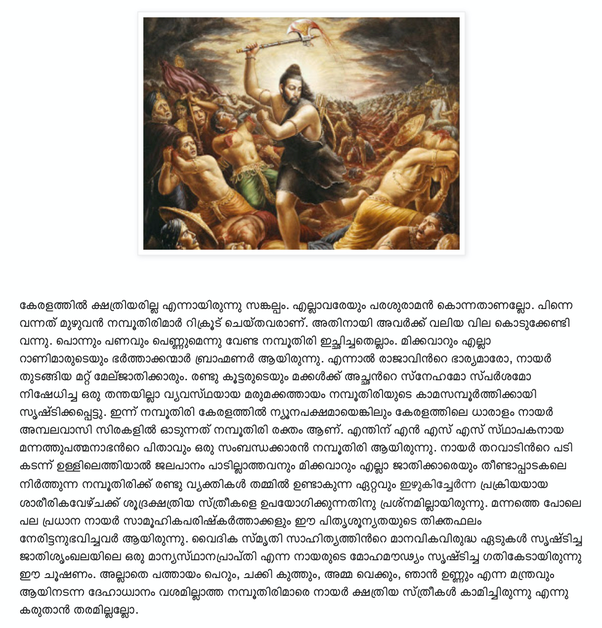
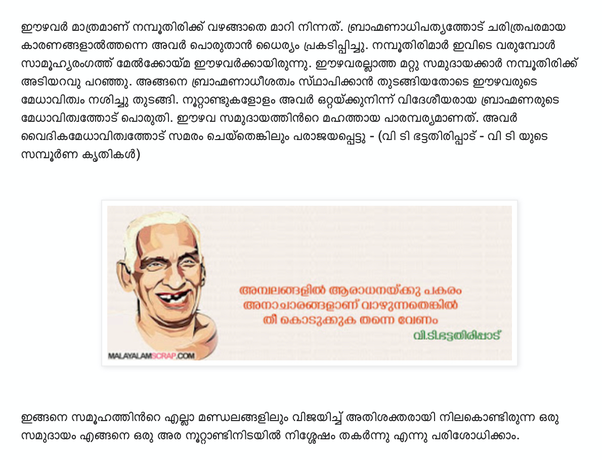
So, the question here, why Nair men/warriors were not courageous and strong enough to prevent the sexual exploitations of their nair women?. How Brahmins succeeded in enslaving nairs women as their sambandham sexual partners, while Nair men were involved in armed forces. But, somehow brahmins able to tactically silent them. This continues until Nair youth woke up under the leadership of Mannathu Padmanabhan. As per the various research papers, Nairs were the intermediary tenants of Brahmins Janmis. This helped Brahmin Namboodhiris to tactically exert their power and supremacy over nairs, who became depended on brahmins for their daily livelihood and other agriculture commodities.
Please see the below research papers:
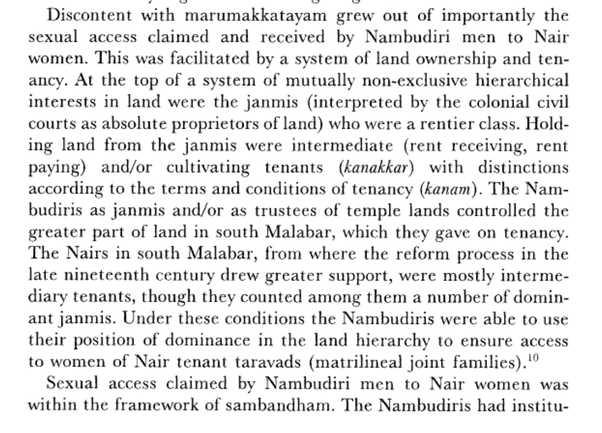


🌺🌺 Though Nairs were heavily exploited by Brahmins, somehow ezhavas who were considered as lower in stature than Nairs, were strongly and tactically able to keep away from such exploitations. 🌺🌺
Some modern day online nairs point out that some poor thiyya ladies (it says outcasted thiyya ladies) were involved in prostitution (No solid historical proof associated with it, some of those writings are referring about Mukuwas and outcasted women). And some are referring to a book written in 2001 !!, either way confusion prevails. But, by making such false allegations, Nairs are in fact spitting their own saliva back onto their faces. Because, if you review modern day — daily news, you can see Nair ladies are mostly at the helm of all the popular penvanibham cases in Kerala. Solar, Kottayam, Kiliroor, chumbana samaram and many other such examples are out there. So here the question is not about prostitions, but about sambandham — an officially accepted practice by Nair community members and they wholeheartedly allowed brahmins to ensalve them as Sambandham partners and though Nairs were considered untouchables by Brahmins.

Also, as per the latest genome researches in India, caste system in India was started around 1700 years ego. Before that, all Indians used to be from a mixed one tribal culture and sharing same genome / DNA with Andaman and nicorbar island tribes.
56K views

vallappozhum samayam kittukayanel sangam literature enna onnundu... eduthu vechu vaayichaal nannayirunnu - Oru nair stree
ReplyDelete